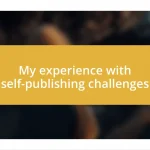Key takeaways:
- Start with attention-grabbing techniques like provocative questions, vivid imagery, or compelling characters to engage readers immediately.
- Understand and connect with your target audience by using relatable themes, emotional hooks, and a language that resonates with them.
- Avoid common mistakes such as overloading the blurb with details, using vague language, and neglecting the emotional journey to maintain curiosity and connection.

Techniques for Writing Attention-Grabbing Openings
One technique I often rely on is starting with a provocative question. For instance, when I first wrote a blurb for a mystery novel, I opened with, “What if the person you trust most is the one you should fear?” This not only sparked curiosity but also set the tone for the entire story. I felt the immediate engagement from readers who are drawn into the intrigue without hesitation.
Using vivid imagery is another powerful way to draw readers in right from the start. I remember crafting a blurb that began with a snapshot of a stormy night, where the winds howled, and shadows whispered secrets. The emotional resonance of that imagery immediately paints a picture, transforming the readers’ experience and making them want to delve deeper into the narrative. How does that moment feel to you? It’s almost like inviting readers to step into the scene themselves.
Lastly, I’ve found that sharing a compelling character or a unique setting can hook readers effectively. For example, I once introduced a blurb with a character facing an impossible choice in a dystopian world. This technique creates an emotional connection and piques interest in both the character’s journey and the world they inhabit. It’s fascinating how just a few carefully chosen words can stir emotions and prompt a longing to discover more.

Engaging Your Target Audience
When it comes to engaging your target audience, understanding their interests and preferences is key. I once tailored a blurb for a young adult fantasy novel and focused heavily on themes of friendships and self-discovery—elements that resonate deeply with that demographic. It was rewarding to see how my choice of words connected with readers who were longing for relatable experiences, and I felt a genuine excitement from my audience as they shared their enthusiasm.
Here are some effective strategies to consider for engaging your target readers:
- Know Your Audience: Research demographics and psychographics to tailor your language and themes.
- Speak Their Language: Use terminology that resonates with their experiences and interests.
- Create Emotional Hooks: Focus on feelings that your audience cares about, like love, fear, or triumph.
- Highlight Relatable Challenges: Reflect common struggles your readers may face within your blurb.
- Wrap in a Promise: Suggest how the story addresses their needs or desires, compelling them to read on.
By genuinely connecting with the intended audience and crafting a blurb that addresses their passions and challenges, I’ve seen firsthand the power of engagement that stems from empathy and understanding.

Common Mistakes to Avoid
One common mistake I see writers make is overloading the blurb with too much detail. I remember trying to cram every exciting plot twist into a blurb, thinking that it would attract readers. Instead, it felt more like a summary than an enticing teaser. Have you ever felt overwhelmed by information and lost interest as a result? Keeping it concise and focused creates curiosity rather than confusion.
Another pitfall is using vague language that fails to paint a clear picture. I once wrote a blurb that described a character as ‘interesting’ without showing what made them so. It’s crucial to choose specific words that evoke images and feelings. Why does ‘interesting’ fall flat? Because readers want to feel an immediate connection to characters and settings, not just know they exist.
Lastly, neglecting the emotional journey can diminish the blurb’s impact. I learned this the hard way when I wrote a blurb that highlighted plot mechanics instead of character emotions and stakes. Think about it: when readers pick up a book, they’re often searching for an emotional experience. Engaging their feelings right from the blurb can make all the difference in capturing their interest.















